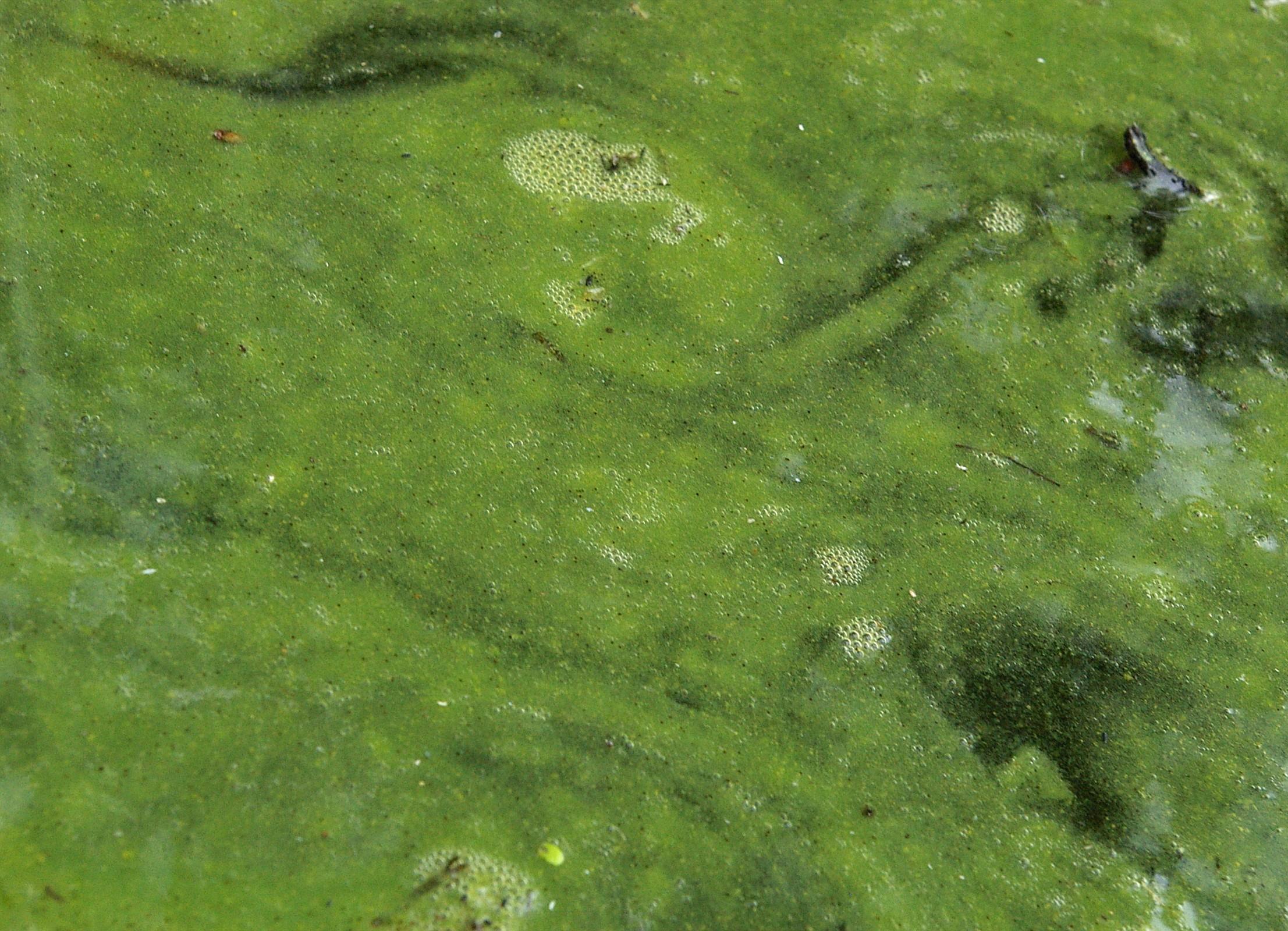Guest post by Lorie Huston, DVM
Summertime brings with it a number of health hazards for dogs.
Among them is the danger of poisoning from blue-green algae.
Blue-green algae, also known as cyanobacteria, is common in stale or stagnant water and is often found in ponds, lakes, reservoirs and other bodies of standing water. Waters affected by blue-green algal blooms are usually of poor water quality. These waters contain large amounts of organic matter and minerals that support plant growth, especially of the algal variety. Algal blooms are most common in hot, humid weather. Often, the algal bloom will be most profuse on the windward side of the lake, pond or reservoir.
It can be difficult to identify a toxic algal bloom.
Often, the water will have a greenish, pea-soup type of appearance. Not all algal blooms are toxic but if there is any doubt about the quality of the water in question, it is best to keep your dog away from the area.
Dogs become poisoned with the toxins found in blue-green algae when they swim or drink from waters where a bloom has occurred.
Blue-green algae contain several toxins, two of which are hepatotoxins (a toxin affecting the liver) and one which is a neurotoxin (a toxin affecting the central nervous system).
The two hepatoxins are known as microcystins and nodularins. These are produced by specific species of blue-green algae, *Microcystis* and *Nodularia. * Other species of blue-green algae, most notably *Anabaena*, *Aphanizomenon * and *Oscillatoria, * produce the neurotoxin, which is specified as anatoxin-a or anatoxin-as.
Symptoms in affected dogs depend on the specific type of blue-green algae present in the water and the type of toxin the algae produces.
Symptoms commonly seen with the hepatotoxins include:
The onset of clinical signs is generally fairly quick, usually within a few minutes to a few hours of ingestion.
Treatment is symptomatic, aimed at treating the individual clinical signs and providing supportive care. The outcome is often fatal. There is no specific antidote available for any of these toxins.
Summertime brings with it a number of health hazards for dogs.
Among them is the danger of poisoning from blue-green algae.
Blue-green algae, also known as cyanobacteria, is common in stale or stagnant water and is often found in ponds, lakes, reservoirs and other bodies of standing water. Waters affected by blue-green algal blooms are usually of poor water quality. These waters contain large amounts of organic matter and minerals that support plant growth, especially of the algal variety. Algal blooms are most common in hot, humid weather. Often, the algal bloom will be most profuse on the windward side of the lake, pond or reservoir.
It can be difficult to identify a toxic algal bloom.
Often, the water will have a greenish, pea-soup type of appearance. Not all algal blooms are toxic but if there is any doubt about the quality of the water in question, it is best to keep your dog away from the area.
Dogs become poisoned with the toxins found in blue-green algae when they swim or drink from waters where a bloom has occurred.
Blue-green algae contain several toxins, two of which are hepatotoxins (a toxin affecting the liver) and one which is a neurotoxin (a toxin affecting the central nervous system).
The two hepatoxins are known as microcystins and nodularins. These are produced by specific species of blue-green algae, *Microcystis* and *Nodularia. * Other species of blue-green algae, most notably *Anabaena*, *Aphanizomenon * and *Oscillatoria, * produce the neurotoxin, which is specified as anatoxin-a or anatoxin-as.
Symptoms in affected dogs depend on the specific type of blue-green algae present in the water and the type of toxin the algae produces.
Symptoms commonly seen with the hepatotoxins include:
- depression
- vomiting
- diarrhea
- weakness
- abnormal coloration of the skin and gums
- shock
- death resulting from liver failure
- muscle rigidity
- tremors
- seizures
- paralysis
- respiratory paralysis
- death
The onset of clinical signs is generally fairly quick, usually within a few minutes to a few hours of ingestion.
Treatment is symptomatic, aimed at treating the individual clinical signs and providing supportive care. The outcome is often fatal. There is no specific antidote available for any of these toxins.

Hello we are new followers from the blog hop! Please check us out at
ReplyDeletehttp://www.lifewith5dogs.com/
Hi, nice to meet you!
ReplyDeleteExcited to read your blog!
Thanks for the safety tip on the aglal blooms. Visiting from the Sat blog hop.
ReplyDeleteCome visit us at:
www.24pawsoflove.blogspot.com
Unfortunately, I was not aware that algae was toxic and I have a pond in my back yard. My beautiful Shepherd cross, Bella, often drank from the pond and must have done so this past week before it was cleaned out for the summer (procrastination on my part) and I had to have her euthanized last Friday. The guilt I feel is overwhelming, and I miss her so very badly - she was with me 24/7 because she came to work with me every day. I don't think I'll ever forgive myself for this.
ReplyDeleteAlyson, so sorry about Bella!
DeleteNot ALL algae is toxic; unfortunately, blue-green algae is. So sorry for your loss.
I'm sure Bella forgives you.